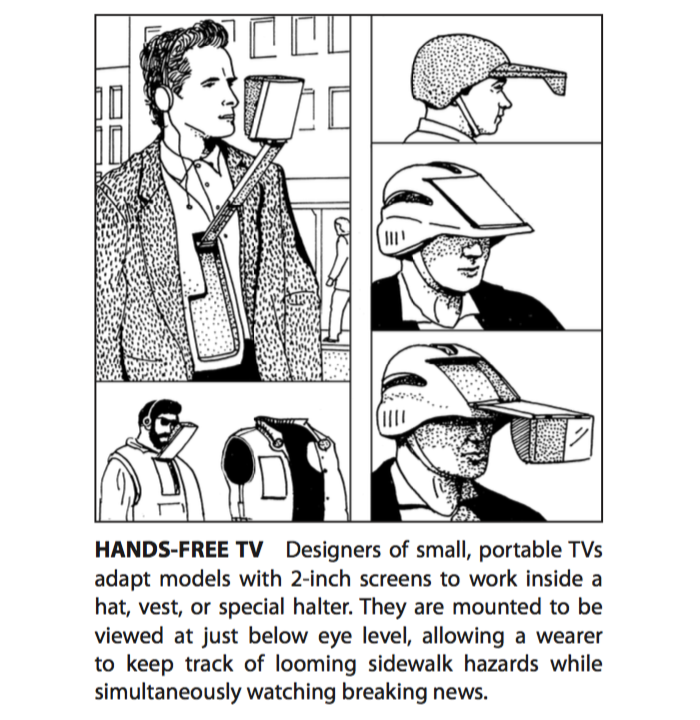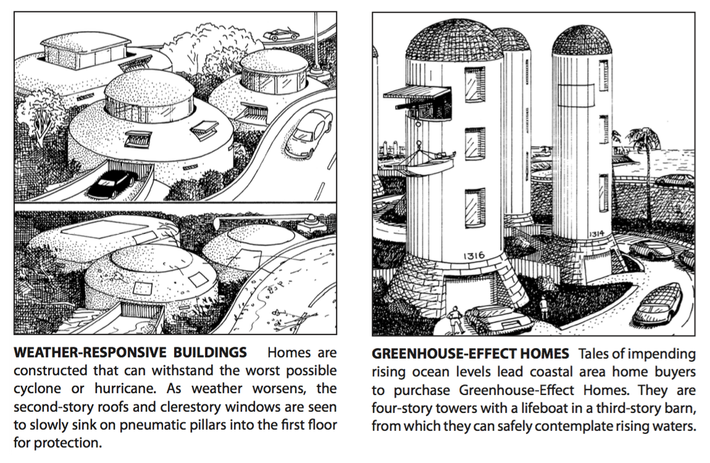
About 12 years ago, I inherited from a roommate an oddball little book filled with illustrations of imagined inventions from a nutty near future: shoes with turn signals to avoid collisions in crowded office corridors, furniture with secret compartments to hide inside during a home invasion, cars with washing machines under the hood for cleaning your clothes while you drive.

The book — Public Therapy Buses, Information Specialty Bums, Solar Cook-A-Mats and Other Visions of the 21st Century, published in 1991 by cartoonist and futurist Steven M. Johnson — quickly became one of my favorites. I loved Johnson’s deadpan delivery, combining ludicrous prognostications with reasonable explanations and un-ironic drawings. His description of the “Whole Mouth Dental Appliance,” which you cram into your face to clean all your teeth at once, simply notes that two different brush configurations are available for fitting by your dentist. So crazy, but so matter-of-factly presented.

And yet, each time I’ve pulled Johnson’s book off the shelf in the past decade, I’ve realized we’re living more and more in the cockamamie and vaguely dystopian world he described 25 years ago. Each time I flip the pages I connect more current-day products to things he predicted decades ago: GoPro cameras, tiny houses, Roomba vacuum cleaners, TaskRabbit-style helpers. Someone has even finally made the customized whole-mouth toothbrush.
“It’s just a little strange thing I do,” Johnson, now 78, told me when I reached him by phone at his home near Sacramento. Although he hasn’t landed a book deal since 1991, he said he still comes up with new ideas, often in a sort of half-asleep state in which he begins to “mix and match” ideas and objects in his mind, “rolling them around as if they’re in a washing machine or a dryer.” Until he says to himself, “Aha! This will come together in the future.”
And often, it does. Google Glass, for example, went on the market in 2013, just over two decades after Johnson predicted computer spectacles in 1992, as part of a spread on possible uses for the Apple Newton.

“It seemed obvious to me that an image could be projected on the inside of a pair of glasses,” Johnson said. Even at the dawn of the internet, Johnson saw where things were headed: people will be constantly connected to electronic devices.
“I don’t know if I predicted it, but I depicted it,” Johnson said modestly. He said he doesn’t have much of a reaction when he sees his drawings come to life. “It’s just a mild form of personal triumph.”
Johnson foresaw a future in which people are ceaselessly consuming information, necessitating devices like “Hands-Free TV,” presaging a reality like ours, in which people look at screens nearly every waking moment.

With constant information access comes constant labor, and Johnson predicted that offices would have to change to adapt to the physical needs of people working long hours. He saw that the trend would lead to combining desks with exercise equipment to create “Fitness Work Stations.”

“It’s a combination invention where you’re thinking, well, perhaps being hunched over at a computer in the future will be bad for lung function and in general,” he said. And, lo and behold, we now have offices with treadmill desks.
I asked Johnson about a related invention, the self-explanatory “Communications Commode.”

“I think it likely exists somewhere,” Johnson said. “Everything that can possibly be invented now is being invented, which is kind of discouraging for me as a futurist. I think of something and I’m almost afraid to Google it.”
I Googled “toilet workstation” and, yes, something like this does unfortunately exist. But lots of people also achieve the same effect just by tapping out emails on their phone while sitting on the john.
Johnson admits that the rise of the smartphone took him by surprise. Although he predicted lots of other features of our digital age, he didn’t realize so many of them would be tied to a single device.
“I failed to see the miniaturization of the phone, and that’s been huge,” Johnson said. He imagined, for example, the ride-sharing now facilitated via smartphone with apps like Lyft and Uber, but thought it would work more like a bus station where riders and drivers would meet.

Johnson also predicted a kind of driverless-vehicle experience with his “Snap-Together Cars,” small vehicles that would link up on highways to allow drivers to relinquish control and relax.

This one initially seems ridiculous — it looks like a kid’s toy. But like a lot of Johnson’s at-first far-out notions, it’s actually already coming true, albeit in a slightly different form. Driverless cars are now able to communicate with each other to “platoon,” coming into formation to decrease wind resistance and increase fuel efficiency.
“The flocking that birds do is now a capability that cars will have,” Johnson said. “So I have this kind of clunky physical manifestation of the same idea.”
Also in the transportation section of his book: the “Trafficscope,” which allows drivers to peer through a periscope and see what’s causing traffic jams down the road. “That’s a frustration issue which I’ve felt, everyone’s felt, you don’t know if the traffic is an accident up ahead or what,” Johnson said.
It’s true. Everyone’s felt it, even Larry David.
There’s plenty to laugh at in Johnson’s work, which can be so amusingly wacky and absurd. But it’s also often darkly satirical, with unnerving undercurrents.
Johnson’s predictions describe a future in which fundamental problems — violence, poverty, isolation — not only haven’t been solved, they’ve gotten worse. The products he imagines often don’t change the world, they’re just workarounds, adaptations to a nasty reality.
Johnson envisioned municipal buses that keep people in separate cells to prevent fights, robotic attack dogs to ward off muggers, and zoning laws that require folding beds in building facades to accommodate a growing homeless population.
One of the saddest examples of his dystopian vision is “Back-To-School Armor,” which is just what it sounds like and, even sadder, is now a real thing.

When he thinks about the future these days, Johnson said, his mind turns toward the disastrous effects of climate change. We ended our conversation on an ominous note, talking about a planetary catastrophe, mass migration, and the stockpiling of resources by the rich.
“My thought is that a prediction about the future cannot be, as it was for me earlier, simply about extrapolations and scenarios that deal with products and technology,” he said in a follow-up email. “The future will involve a disorderly movement of peoples, animals, and plants out of tropical regions, and which will occur at a time of worsening air. So, while it is fun for me to predict new cities, new technologies, they must happen against the background of increasingly stressful changes in the environment.”
It’s a grim vision indeed. But, looking again at Johnson’s great book, I realized he’s already shown us some possible ways to adapt, with homes that turn into stormproof bunkers and flood-ready tower-houses equipped with boats.

And with Johnson’s track record, there’s a good chance these inventions will be around if and when we need them.